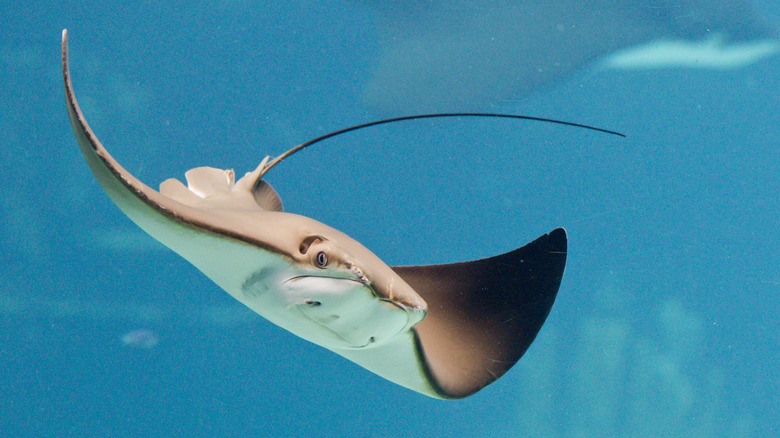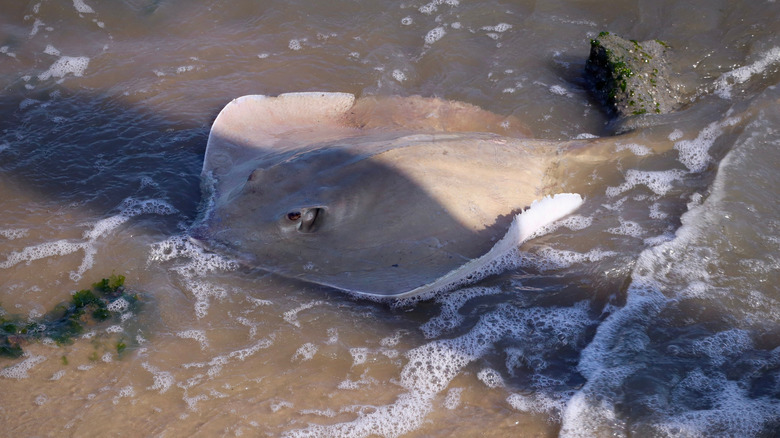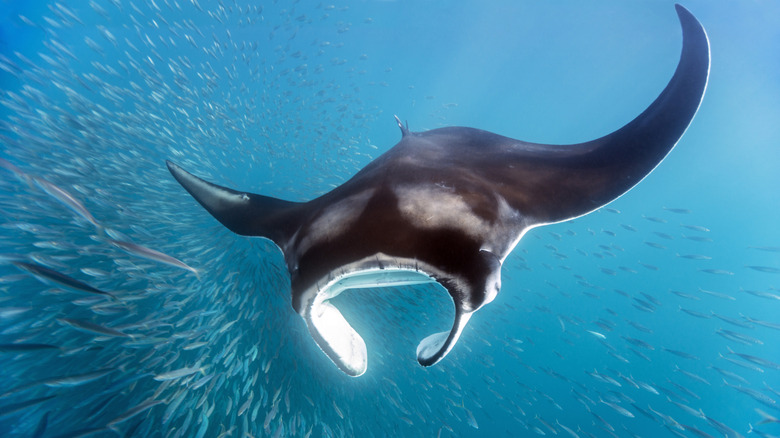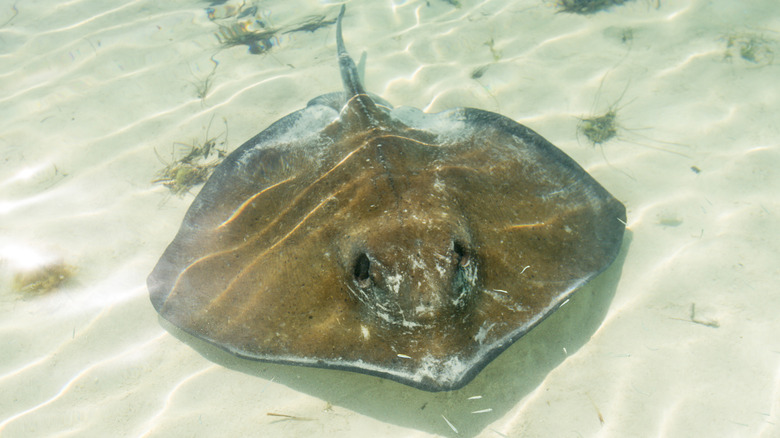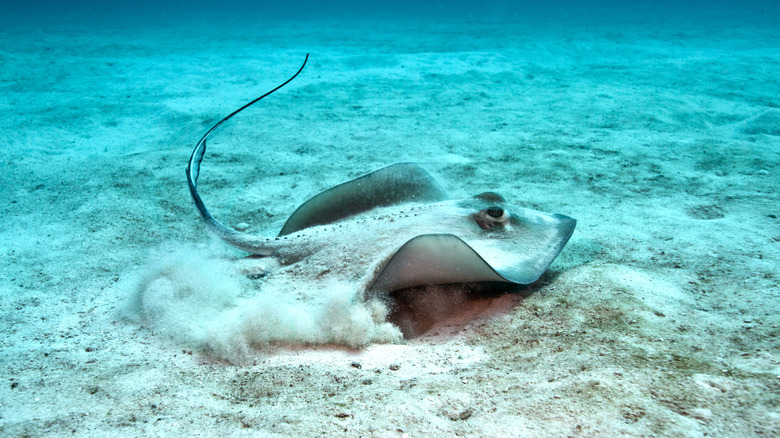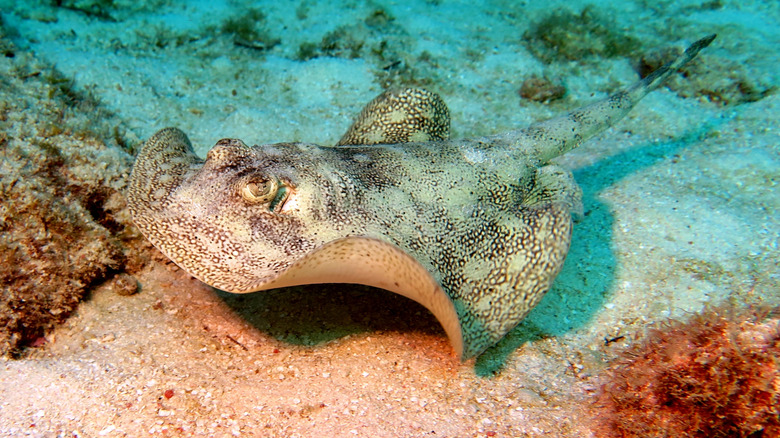Stingrays You Might See In Florida (And How To Avoid Them)
Florida's expansive 1300-mile coastline is home to a staggering number of beaches and even more varied sea-related experiences. Whether you want to lay down a towel and sip on a cold one with other beachgoers or escape to white-sand panhandle paradise, Florida's got it all. It's not only a colorful variety of people and beaches that you'll encounter, but an equally spectacular range of marine biodiversity. Florida's ocean life, while richest in its coastal state and national parks, flourishes all along the shoreline which straddles both the Gulf of Mexico and the Atlantic Ocean. Those who enjoy observing marine life in its natural habitat have several options, like the best Florida beaches for spotting dolphins. However, even if it's not your thing, you cannot ignore the presence of marine life, and sometimes that means being cautious.
Stingrays are exotic yet abundant, non-aggressive, yet potentially dangerous. Despite being closely related to sharks, it's not their bite you need to watch out for, since these majestic creatures mostly feed on mollusks and small sea creatures. The poisonous stingers on their tails, however, can cause serious injury, and in rare cases, death. There are about 200 varieties of stingrays which can range in size from a few inches to several feet. While not all, several varieties like to hunt near the sea floor, making them especially susceptible to being stepped on, which could result in a stinging rebuttal. Fortunately, there are simple ways, like doing the "stingray shuffle" by dragging your feet in the sand to alert them, that can help you avoid getting stung.
Atlantic stingray
The Atlantic stingray is on the smaller side of the spectrum and only grows to about 12 inches in size. However, these are exactly the kind of stingrays that you need to watch out for when swimming in Florida's beaches. As bottom dwellers, they can be found near the sandy ocean floor and their rusty brown coloring makes it particularly difficult to spot them. Combined with the long venomous spines on its tail, the Atlantic stingray is a particularly dangerous fish to step on. While it's unlikely to attack you if it's undisturbed, these stingrays will use their stingers when threatened.
Because of their small size, Atlantic stingrays can be found close to the shore. They thrive in both fresh and salt water, which means you need to watch out for them whenever you're in the sea but also in lakes and rivers. Shuffling your feet while wading through shallow waters can help warn these stingrays and avoid any unfortunate contact with their spines.
Manta ray
Manta rays are one of the most popular varieties of stingray, and you'll often see them in nature documentaries. The giant manta ray, found off the coast of Florida, is the largest stingray variety on the planet and can grow to have a wingspan of almost 30 feet. Despite the imposing size and gaping mouth, they feed mainly on plankton and small fish. Most notably, manta rays don't have stingers on their tails and do not pose much of a threat to humans. Even their teeth are designed to consume minuscule food, so you don't need to worry about being bitten or attacked.
While it's unlikely to see one of these imposing creatures near the beach, they are known to swim in shallow waters and can sometimes be seen leaping out from the sea. You're much more likely to come across a manta ray while snorkeling around a reef or if you decide to take a boat ride to one of Florida's beautiful sandbar islands. Interestingly, a rare manta ray nursery was discovered in 2021 in the Gulf of Mexico where adolescent manta rays spend the first 4-5 years of their lives before venturing out into the open ocean.
Bluntnose stingray
The bluntnose stingray is particularly common around the Florida coast. About 3-4 feet in width, this medium-sized, diamond-shaped stingray is easy to identify because of its prominent blunt snout. It also blends seamlessly with the ocean floor because of its gray-brown color, making it another one of those stingrays you need to watch out for. The long venomous spine at the end of a tail that's longer than its body makes the bluntnose stingray particularly dangerous. Since they are mostly nocturnal, these fish spend the day buried in the shallow sand, which is when they are more susceptible to being stepped on.
Adult bluntnose stingrays are likely to be found in water depths greater than 3 feet. They also move away from coastal regions during winter months, so you're less likely to run into them then. A similar looking stingray is the cownose ray, which also has a blunt snout. However, these stingrays generally swim near the surface of the water, and therefore you are in much less danger of accidentally stepping on one.
Southern stingray
The Southern stingray is one of the most common stingray varieties in Florida and thrives in the warm, shallow waters of the region. Growing to a width of up to 5 feet, these dark gray stingrays are bottom dwellers that spend most of their time on the ocean floor. Fortunately, their size and long whip-like tail make them easier to spot than smaller stingrays. However, the base of their tail contains a poisonous barb which swimmers in shallow waters must watch out for.
Once again, the stingray shuffle is the best way to avoid stepping on a Southern stingray. Apart from the sea, they can also be found near river mouths and in areas with underwater grass, so make sure to wade carefully when venturing into underwater foliage.
Yellow stingray
Another Florida regular, the yellow stingray can regularly be spotted in shallow waters because of its relatively brighter coloring which is a mix of yellow, light brown, and white. In fact, yellow stingrays have been known to glow in the dark. These fish are rounder in shape than most other stingrays, have a width of about 12-14 inches, and can be found amongst coral reefs and grassy sea floors.
Due to their coloring, you're less likely to accidentally step on one if you walk carefully in the shallows. However, you need to be extra careful when snorkeling around coral reefs and underwater rocks, which yellow stingrays can very easily camouflage against. While their sting is rarely fatal, it can be painful and require quick medical attention. If you spot a yellow stingray, don't panic as they, like many other stingray varieties, are not aggressive. As long as you don't make sudden movements around them that may appear threatening, you can enjoy being around and observing these colorful stingrays.
